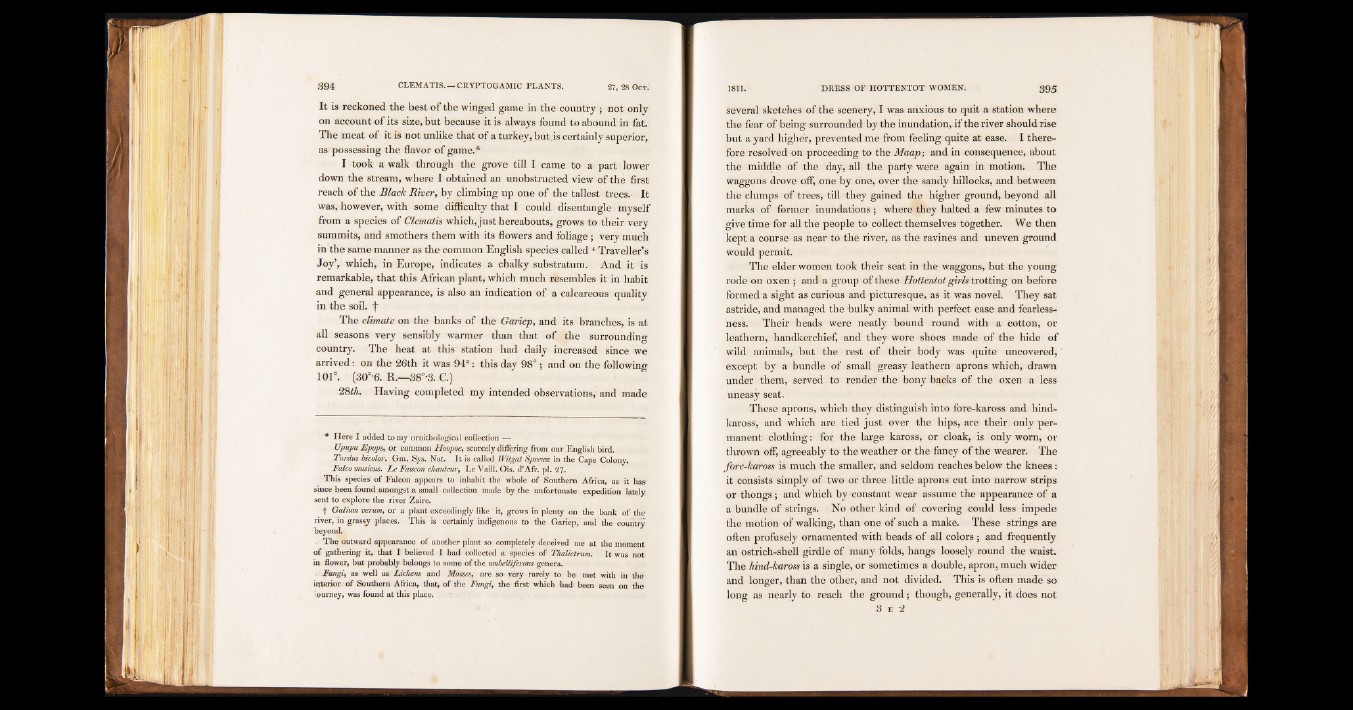
It is reckoned the best of the winged game in the country ; not only
on account of its size, but because it is always found to abound in fat.
The meat of it is not unlike that of a turkey, but is certainly superior,
as possessing the flavor of game.*
I took a walk through the grove till I came to a part lower
down the stream, where 1 obtained an unobstructed view of the first
reach of the Black River, by climbing up one of the tallest trees. It
was, however, with some difficulty that I could disentangle myself
from a species of Clematis which, just hereabouts, grows to their very
summits, and smothers them with its flowers and foliage; very much
in the same manner as the common English species called ‘ Traveller’s
Joy’, which, in Europe, indicates a chalky substratum. And it is
remarkable, that this African plant, which much resembles it in habit
and general appearance, is also an indication of a calcareous quality
in the soil, f
The climate on the banks of the Gariep, and its branches, is at
all seasons very sensibly warmer than that of the surrounding
country. The heat at this station had daily increased since we
arrived: on the 26th it was 94“: this day 98°; and on the following
101°. (30°'6. R.—38°-3. C.)
28th. Having completed my intended observations, and made
* Here I added to my ornithological collection —
Upupa Epops, or common Hoopoe, scarcely differing from our English bird.
Turdus bicolor. Gm. Sys. Nat. It is called Witgat Spreuvo in the Cape Colony.
Falco musicus. L e Faucon chant cur, LeVaill. Ois. d’Afr. pi. 27.
This species of Falcon appears to inhabit the whole of Southern Africa, as it has
since been found amongst a small collection made by the unfortunate expedition lately,
sent to explore the river Zaire.
f Galium verum, or a plant exceedingly like it, grows in plenty on the bank of the
river, in grassy places. This is certainly indigenous to the Gariep, and the country
beyond.
The outward appearance of another plant so completely deceived me at the moment
of gathering it, that I believed I had collected a species of Thalictrum. It was not
in flower, but probably belongs to some of the umbelliferous genera.
. Fungi, as well as Lichens and Mosses, are so very rarely to be met with in the
interior, of Southern Africa, that, of the Fungi, the first which had been seen on the
\oumey, was found at this place. .' ■ • .
several sketches of the scenery, I was anxious to quit a station where
the fear of being surrounded by the inundation, if the river should rise
but a yard higher, prevented me from feeling quite at ease. I therefore
resolved on proceeding to the Maap; and in consequence, about
the middle of the day, all the party were again in motion. The
waggons drove off, one by one, over the sandy hillocks, and between
the clumps of trees, till they gained the higher ground, beyond all
marks of former inundations ; where they halted a few minutes to
give time for all the people to collect themselves together. We then
kept a course as near to the river, as the ravines and uneven ground
would permit.
The elder women took their seat in the waggons, but the young
rode on oxen ; and a group of these Hottentot girls trotting on before
formed a sight as curious and picturesque, as it was novel. They sat
astride, and managed the bulky animal with perfect ease And fearlessness.
Their heads were neatly bound round with a cotton, or
leathern, handkerchief, and they wore shoes made of the hide of
wild animals, but the rest of their body was quite uncovered,
except by a bundle of small greasy leathern aprons which, drawn
under them, served to render the bony backs of the oxen a less
uneasy seat.
These aprons, which they distinguish into fore-kaross and hind-
kaross, and which are tied just over the hips, are their only permanent
clothing : for the large kaross, or cloak, is only worn, or
thrown off, agreeably to the weather or thè fancy of the wearer. The
forè-kaross is much the smaller, and seldom reaches below the knees :
it consists simply of two or three little aprons cut into narrow strips
or thongs ; and which by constant wear assume the appearance of a
a bundle of strings. No other kind of covering could less impede
the motion of walking, than one of such a make. These strings are
often profusely ornamented with beads of all colors ; and frequently
an ostrich-shell girdle of many folds, hangs loosely round the waist.
The hind-kaross is a single, or sometimes a double, apron, much wider
and longer, than the other, and not divided. This is often made so
long as nearly to reach the ground ; though, generally, it does not
3 e 2